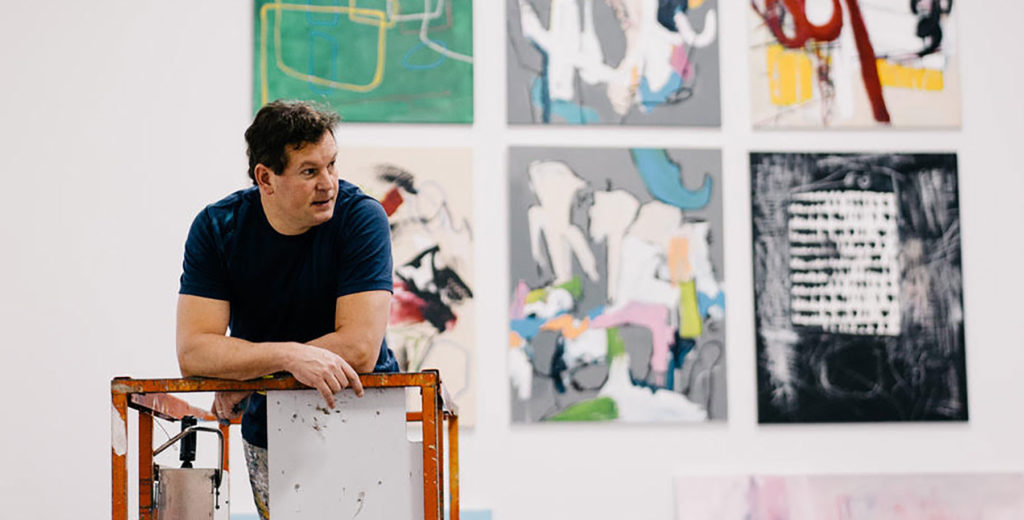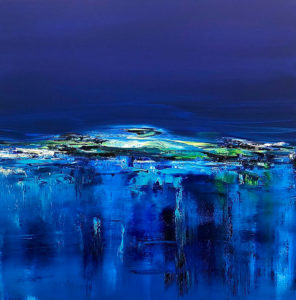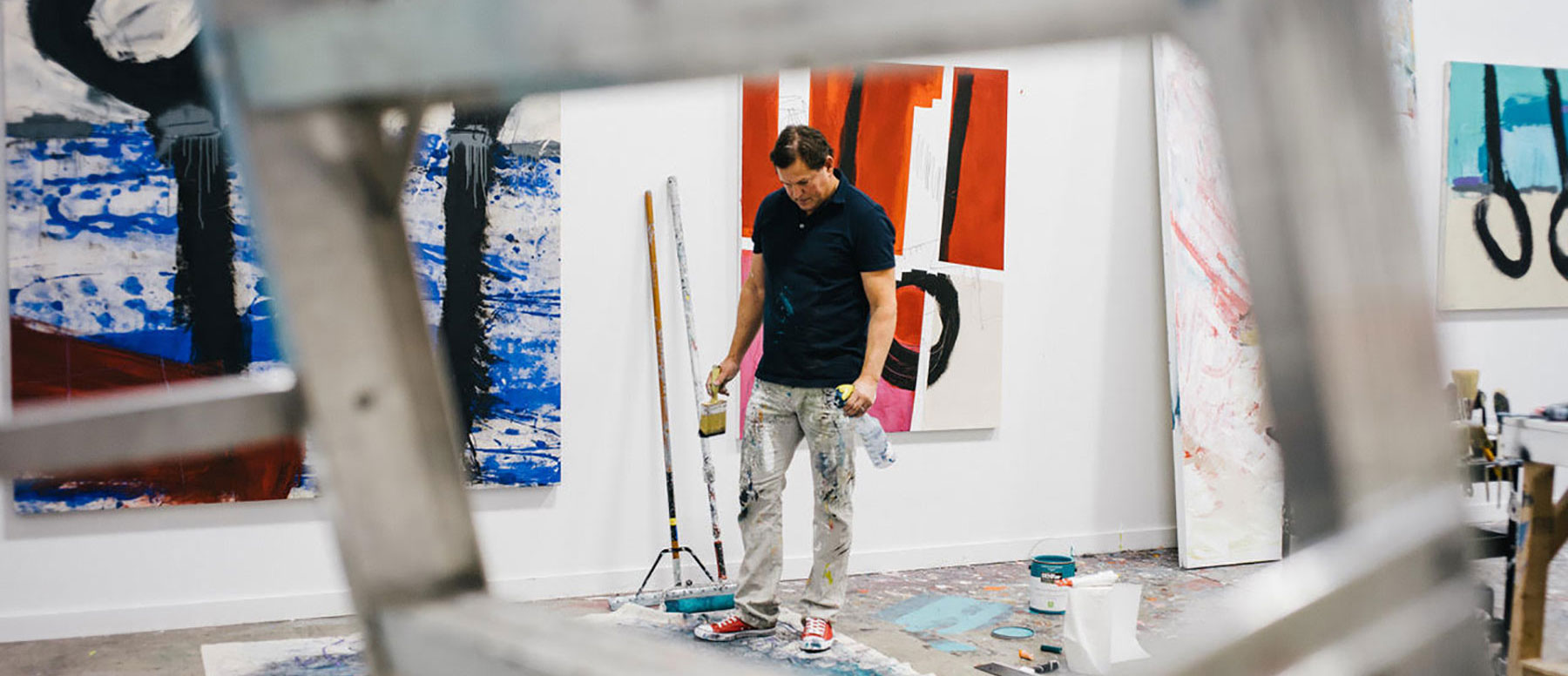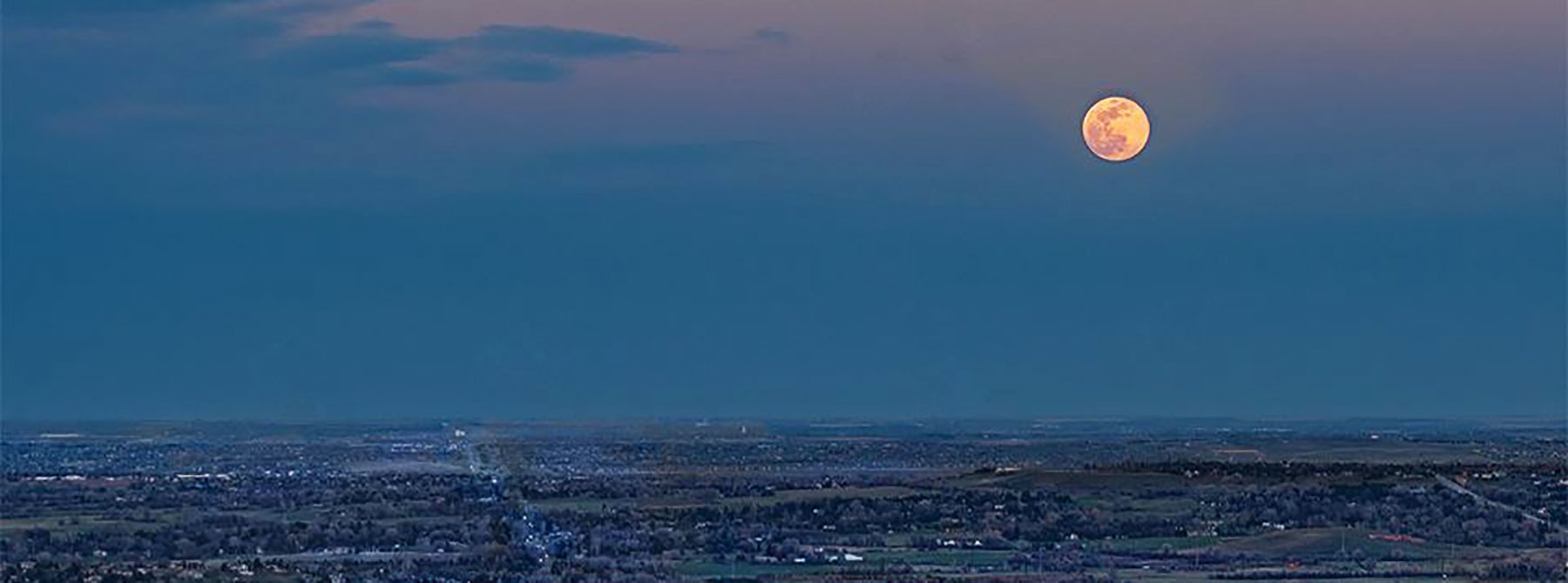Visual artists who make a living at their art are few and far between. We decided to dig deeper by profiling a local full-time artist who appears to have figured out how to monetize his art while living in Boulder.
Will Day, a local abstract expressionist painter from New York, has held his full-time studio practice for 11 years. He creates colorful, large-scale works using a variety of mediums from oil paint and acrylics to charcoal and sometimes spray paint. He works on the ground, or on the walls, smearing, scraping, throwing, rolling and brushing colors into shapes. Will’s visceral paintings have an architectural structure that expresses a vibrant energy.
From the moment Will picked up the phone for our interview, the space between us filled with light as 1950’s jazz played in the background. “I like to start my mornings in studio with some blues or jazz,” says Will. He leases studio space from Black Lab Sports at 3550 Frontier Ave, a local venture capital firm that also operates co-working space from its headquarters. It has allowed him room for his massive paintings and messy processes for three and a half years.

Like many working artists, Will has had to balance the pure inspiration to create with the reality of making a living. This tension can weaken art, as artists typically create their most powerful work when they tap into motivation beyond money. Some successful artists supplement their income by teaching, others by making it a full industry; others don’t ever find commercial success, others only after passing. Will tackled this balance challenge as an entrepreneur.
When he first started out in 2007 shortly after moving to Boulder, Will formed a board of directors who helped him generate market and business strategy to make it as an artist. Most importantly, he needed money every month to support his wife and two children. Through meetings with his board, he began leasing art to corporations — getting paid every month and covering his costs. This laid the foundation to help Will start generating inventory and selling his paintings.
The first three or four years proved painful, but Will was committed to painting. Today, he usually keeps between six to seven leasing clients, including Boulder Plastic Surgery, Conscious Bay Company, and Kurtz Fargo LLC. Will holds a flat fee for leasing art, between $500-$1,000 per month.
Leasing art creates a way for people who may not be able to afford original art outright to still have beautiful work in their offices, and also the ability to lease-to-own.

While pieces like his blue horizons, such as “Eyes of the Word,” tend to do well, and very abstract, contemporary pieces that often sell to corporations, Will says that there’s no general “best sellers.” On average, he sells about two to three paintings a month.
Approximately 75 percent of Will’s total income comes from selling paintings and commission work, with his art leasing business pulling in around 25 percent.
He’s made enough to support his wife and two children as well as the Boulder home they own.
To Will, success lies not just in making a living but in showing up authentically, the ability to create free from the say of a gallery or museum, in being ready for the call.
The Work + Origin
His website hosts series he works in, with themes such as “Healing,” “Awakening, “Water,” “Black and White.”
“People commission me a lot,” says Will. “That’s the truth. That’s behind the scenes. They see something on my website and say ‘I need it ten feet, twenty feet!’ I’m like, wow, okay let’s make it happen.”
While Will strives to remain true to his voice in the studio, he also prioritizes listening to what the world is looking for — staying real, forward-thinking, and humbling himself. He tries to tell stories that relate to real things, like going through the darkness to find the positive. He stays as connected as he can, showing up, attending events, really tuning in to capture real moments.
Will, who worked on Wall Street, never wanted to be a painter; he was an entrepreneur and creative thinker. After his wife, who worked in the World Trade Center, Tower II, survived the chaos of 9/11 through being late for work (though the second plane directly took out her conference room on the 78th floor), Will realized he needed a shift; he wanted to use his creative spark. He went back to get his masters in architecture from Pratt.
But after moving from New York to LA where he worked with architectural firm Gensler, Will still wasn’t using his hands. If he wanted to change his life, he had to get his hands dirty. He and his wife picked up and moved to Boulder, which they saw as a better place to raise their two children than LA.
One night soon after, he went to the garage, threw down a raw canvas and started painting. It was 2007.
Today, his paintings fill walls all over the country and in several private collections overseas, he leases a beautiful studio at Black Lab Sports warehouse space on Pearl Street, has appeared in multiple publications such as Forbes, Art of the Times and others.

“Painting is a dynamic relationship with the world,” says Will. “It’s about letting go of ego and letting the spirit of creativity flow through you. It’s emotionally letting go. You’re storytelling and even working with clients — it’s being a part of something bigger.”
Boulder + Art
While Boulder provides a lot more freedom and relaxed lifestyle than New York and Los Angeles, it also fosters a very different kind of dialogue, Will says. Rather than the rich grounds bigger cities provide for shows or networking, Boulder’s atmosphere provides a better lifestyle to raise a family and open space for the spirit to fly. Conversations in more established art centers feature heavy art speak. Boulder facilitates a more emotional dialogue and transaction.
“People in those cities have been around art a lot longer, they tend to already have numbers in mind,” says Will. “There are some amazing collectors in the Denver Metro region, some of the best in the world. Often people are first-time buyers here.” Those first-time buyers may not have as much knowledge about art history, and their approach to collecting is fresh + raw. Sophistication also often differs, of course, on price points.
The hardest thing about working in Boulder is that Will still feels like an outsider. He tries to be intentional about how to take part in the art scene, to include people, to do events, but it can prove hard to get noticed.
Will’s biggest advice to artists is to find a system that connects with people and to show some value that’s inspiring and timeless. For him, leasing his art created a foundational income to free him to create. “Figure out what you want and what you want to give up,” says Will. “Anyone can do this. It’s a story about all of us.”
Header Image: A peek into Will’s studio. Image: Michael Ash.



